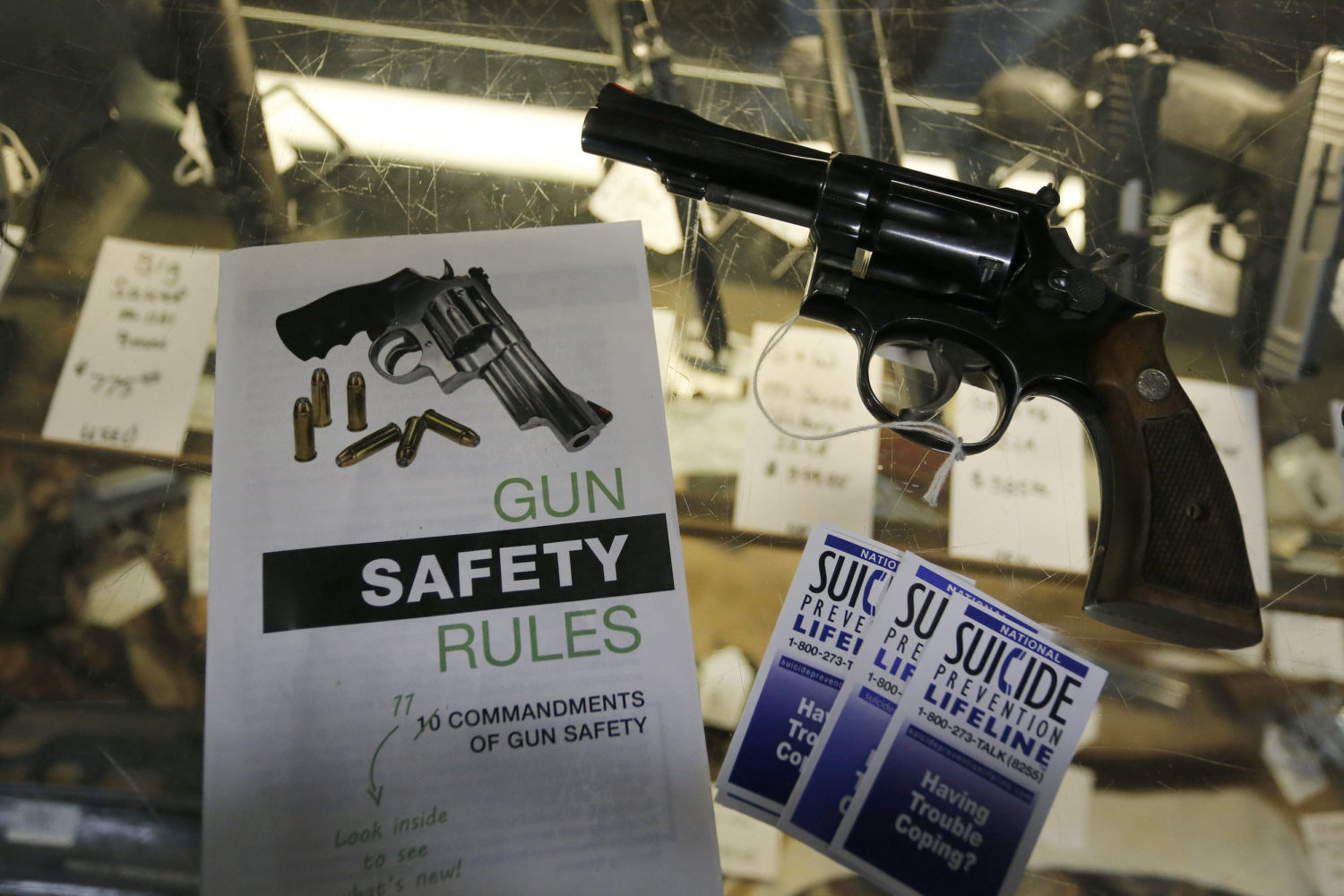
The Morning Meeting with Al Tompkins is a daily Poynter briefing of story ideas worth considering and more timely context for journalists, written by senior faculty Al Tompkins. Sign up here to have it delivered to your inbox every weekday morning.
Much of the national debate over gun laws focuses on homicide, and why not? That is what gets the most media coverage. That is what is visible to the public. But Harvard Public Health, in its just-published study on gun deaths in the U.S., put it this way:
Indeed, as the Giffords Law Center to Prevent Gun Violence puts it, suicide is “the untold story of gun violence in America.” Both suicides and gun deaths have increased over the last two decades, and there is a strong link between firearms and suicide deaths. Suicide-by-gun makes up most of both gun deaths and overall suicide deaths (over half of each).
Here are some of the major findings:
- Firearm suicides have ticked steadily upward since 2004, peaking in 2021.
- Suicide rates overall have also increased significantly over the past two decades, nearly 30 percent.
- The American Indian and Alaska Native population, especially, is feeling this pain, with suicide being a leading cause of death in these communities.
- White Americans, and white men in particular, who are most likely to pick up a gun to take their own lives. Eight in 10 gun suicide deaths in the U.S. involve white Americans.
- Access to a firearm is a major risk factor for suicide, as studies like this 2020 New England Journal of Medicine report show. And while it’s difficult to generalize about a whole group, we can say that a lot of white men own guns—about half, compared to roughly a quarter of white women and non-white men, and one in six non-white women. “It is not surprising that the group with the broadest firearm ownership and access sees elevated rates of firearm suicide,” says Kelly Drane, Research Director at the Giffords Law Center to Prevent Gun Violence.
- 85 percent of people who attempt suicide with a gun die. In fact, though suicide-by-gun only represents five percent of all suicide attempts, it represents about half of all suicide deaths because they are so deadly.
The study acknowledges that some states are trying measures like red flag laws to at least temporarily remove guns from people who might harm themselves or others. There is not yet enough data to prove if those laws work. Another effort involves “safe storage” locations. The notion is that if a person is in crisis, there are places they could be storing a weapon outside the home. The study says:
Rutgers University’s Gun Violence Research Center has created a searchable online map that shows safe gun storage locations like firearm retailers, community businesses, and even police departments for people during a crisis. Emmy Betz, an emergency physician who directs the Firearm Injury Prevention Initiative at the University of Colorado School of Medicine has been leading the charge on how to map safe storage spots. She and her colleagues put together an online toolkit with an overview of existing maps, issues, and how to build a state map.
The Rutgers project identifies safe storage facilities in New Jersey, Colorado, Maryland, Mississippi and Washington state.
Is ‘run, hide, fight’ still the best protocol to follow in an active shooting?
When you attend or watch safety programs, as I have many times, you learn how to respond in an active shooter situation. Police say to follow the mantra of “run, hide, fight,” in that order. Get out or get hidden. Don’t dive for cover first; get out of harm’s way first. Homeland Security and other agencies still use the advice in their trainings. Run, hide, fight.
But some agencies are wondering if the advice is outdated. CNN explores the topic:
The “run, hide, fight” guidance has been used for decades, but CNN National Security Analyst Juliette Kayyem, who also served as a former security official under the Obama administration and now is the faculty chair of the homeland-security program at Harvard’s Kennedy School of Government, said the increased frequency of shootings and more advanced weaponry may necessitate amended guidance.
“Things have changed. There’s more mass shootings, the weaponry is faster, it’s more deadly, a lot of damage can be done in a little period of time. And as we’ve seen in some cases, we can’t totally depend on law enforcement,” Kayyem said.
Kayyem, who previously wrote an Op-Ed for the Atlantic on the topic, now says engaging the gunman may prove to be more effective than a “last resort” option.
“With killers having the capacity to end the lives of so many people so fast, neither running nor hiding may be the best first option. It is our reality. I don’t love it; I don’t even like it,” Kayyem wrote in November.
For the past eight years in Franklin County, Ohio, authorities have adopted a different way of teaching the community how to respond to an active shooter situation: “avoid, deny, defense.”
Sheriff’s Deputy Mike Fetherolf said the biggest difference between their alternate protocol and “run, hide, fight” is the shifting away from the “hide” tactic. Instead, the guidance advises doing what you can to deny the shooter access to you – such as keeping your distance and creating barriers – rather than hiding and potentially waiting for a gunman to find you.
Half of all active shooter events end one way or another before police arrive, making civilian training critically important. Newsrooms, and all workplaces, should conduct this training. Journalists can help educate the public about the best ways to increase their chances of survival and lower their risks. Some police departments offer threat assessment audits that help churches and businesses improve their safety protocols.
Where they bury children who die from gun violence
I came across this story when I spotted this Twitter post:
Hello New Followers: I’m Cara. I’m a Black mother who covers gun violence, racial trauma and health for @KHNews. I’m based in the Midwest. My latest story honors the groundskeepers of a cemetery where young #gunviolence victims are buried. Read it here: https://t.co/4JydNQn79E pic.twitter.com/XcF5Y7no8C
— Cara Anthony (@CaraRAnthony) January 31, 2023
The story takes us to a cemetery just outside of St. Louis to meet caretakers who maintain a section for children called Baby Land. More recently, the cemetery added another section for older children and teens called Garden of Grace. The workers there are busy digging graves for victims of gun violence.
NPR and Kaiser Health News report:
More than 30 years ago, Johnnie Haire and the other groundskeepers built a garden site just for children, separate from unlabeled sections of the 30-acre cemetery where they used to bury infants. They added a birdbath and bought angel figurines, carefully painting each one a hue of brown. Haire wanted the angels to be Black, like many of the children laid to rest here.
“This is ‘Baby Land,’” said Haire, 67, Sunset Gardens’ grounds supervisor, as he gestured across the area. “This is where a lot of babies are buried.”
Cemeteries like this one have long honored those who die too young. Such special burial sites exist in Gainesville, Florida; Quincy, Illinois; Owensboro, Kentucky; and beyond. They are for stillborn children and those who died of disease or accidents.
Today, a modern epidemic fills more graves than anything else: In the U.S., firearm-related injuries were the leading cause of death for children in 2020, ahead of motor vehicle crashes, according to researchers from the University of Michigan.
The closing paragraphs of the online story will linger in your mind:
Digging graves for a living wasn’t on the career list for Belt or his friend Haire. But that’s exactly what the two men have done for some 43 years — whether it’s for those who lived long, full lives or those whose young lives were cut short. They’re caretakers.
“That’s the proper name for it,” Haire said.
As he stood amid the graves on a recent day, he noted that the wooden Baby Land sign that welcomes mourners is worn. The paint on the angels is peeling, too.
“It needs touching up over there,” Haire said. “But I’ve been busy.”
Listen to the full story here or watch a video version of the story here.
There is a spy balloon floating over you
Maybe it is just me, but I would think the Pentagon would be more freaked out than it apparently is about a Chinese surveillance balloon that is floating over the United States. The Pentagon says it thought about shooting it down, but hasn’t.
Pentagon spokesman Brig. Gen. Patrick S. Ryder said, “The balloon is currently traveling at an altitude well above commercial air traffic and does not present a military or physical threat to people on the ground.”
The Pentagon also said that it has seen this kind of thing before and that shooting the balloon down might present a threat to people and things on the ground. The big difference in this balloon is that it is staying over the U.S. longer than usual.
NBC News reports, “The high-altitude balloon was spotted over Billings, Montana, on Wednesday. It flew over the Aleutian Islands, through Canada, and into Montana. A senior defense official said the balloon is still over the U.S. but declined to say where it is now.” NBC News reports:
The U.S. is confident the balloon belongs to China, the official said, and they have communicated to the Chinese government “through multiple channels both here in D.C. and in Beijing.” The official did not say whether the Chinese admitted the balloon was theirs.








I love the Morning Meeting format where I can quickly scan little abstracts, then decide if I want to see the entire newsletter. It spares my old clicker/ scroller hand so it spends less time with the heating pad after work. I wish other pointer newsletters would do this.